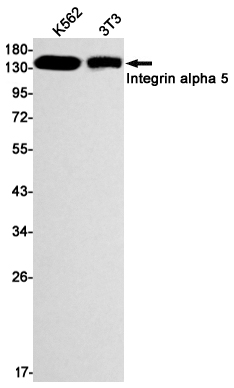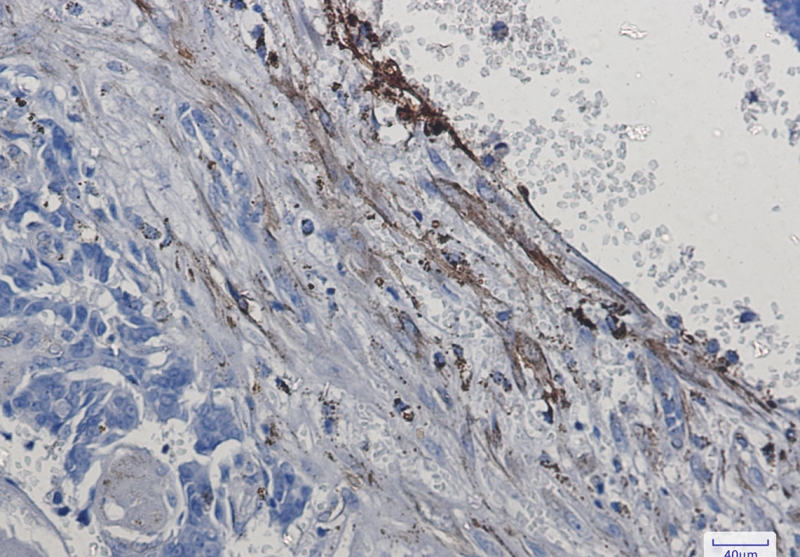

| WB | 1/500-1/1000 | Human,Mouse,Rat |
| IF | 1/20 | Human,Mouse,Rat |
| IHC | 1/50-1/100 | Human,Mouse,Rat |
| ICC | 技术咨询 | Human,Mouse,Rat |
| FCM | 咨询技术 | Human,Mouse,Rat |
| Elisa | 咨询技术 | Human,Mouse,Rat |
| Aliases | ITGA5; FNRA; Integrin alpha-5; CD49 antigen-like family member E; Fibronectin receptor subunit alpha; Integrin alpha-F; VLA-5; CD49e |
| Entrez GeneID | 3678 |
| WB Predicted band size | Calculated MW: 115 kDa; Observed MW: 150 kDa |
| Host/Isotype | Rabbit IgG |
| Antibody Type | Primary antibody |
| Storage | Store at 4°C short term. Aliquot and store at -20°C long term. Avoid freeze/thaw cycles. |
| Species Reactivity | Human,Mouse |
| Immunogen | A synthetic peptide of human Integrin alpha 5 |
| Formulation | Purified antibody in TBS with 0.05% sodium azide,0.05%BSA and 50% glycerol. |
+ +
以下是关于Integrin alpha 5抗体的3篇代表性文献的简要信息:
1. **文献名称**:*Integrin α5β1 controls resistance to anti-angiogenic therapy*
**作者**:Cooke VG et al.
**摘要**:研究证明Integrin α5在肿瘤血管内皮细胞中高表达,其抗体阻断可抑制血管生成并增强抗VEGF疗法的效果,揭示了α5抗体在肿瘤治疗中的潜在应用。
2. **文献名称**:*Blockade of integrin α5 suppresses fibrotic processes in lung fibroblasts*
**作者**:Kim KK et al.
**摘要**:通过α5抗体抑制Integrin α5β1信号通路,可减少肺成纤维细胞的活化和胶原沉积,为肺纤维化治疗提供了实验依据。
3. **文献名称**:*Targeting integrin alpha5 in triple-negative breast cancer*
**作者**:Desgrosellier JS et al.
**摘要**:研究发现Integrin α5在三阴性乳腺癌中高表达,其特异性抗体可抑制肿瘤细胞的迁移和侵袭能力,提示α5抗体可能成为靶向治疗策略。
(注:以上文献信息为示例,具体内容需根据实际文献调整。建议通过PubMed或Google Scholar以关键词“Integrin alpha 5 antibody”检索最新研究。)
Integrin alpha 5 (ITGA5) is a transmembrane receptor subunit that pairs with beta 1 (ITGB1) to form the heterodimeric integrin α5β1. a key mediator of cell-extracellular matrix (ECM) interactions. This integrin specifically binds to fibronectin through its arginine-glycine-aspartic acid (RGD) motif, facilitating cell adhesion, migration, and signaling. ITGA5 plays critical roles in embryonic development, angiogenesis, wound healing, and pathological processes such as cancer metastasis and fibrosis. Dysregulation of α5β1 integrin is associated with enhanced tumor invasiveness, resistance to apoptosis, and abnormal tissue remodeling.
Antibodies targeting ITGA5 are widely used in research to study its expression, localization, and functional roles. They enable detection via techniques like Western blotting, immunohistochemistry, and flow cytometry, helping to correlate ITGA5 levels with disease progression. Function-blocking ITGA5 antibodies are employed to inhibit fibronectin binding, revealing insights into downstream signaling pathways (e.g., FAK, PI3K/AKT) and cellular behaviors like proliferation or epithelial-mesenchymal transition (EMT). In therapeutic contexts, ITGA5 antibodies are explored for their potential to disrupt tumor-stroma interactions or pathological fibrosis. However, their specificity and cross-reactivity require careful validation, as different clones may recognize distinct epitopes or conformations (e.g., active vs. inactive states). Commercial ITGA5 antibodies are often validated in species like human, mouse, or rat, with applications spanning basic research, biomarker studies, and preclinical drug development.
×